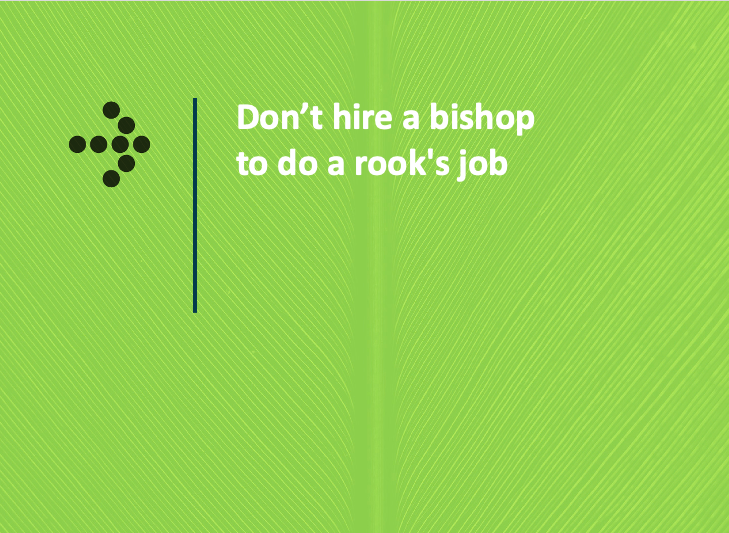Don’t hire a bishop to do a rook’s job

By Hendrik Bronkhorst, industrial psychologist and lead consultant at Evalex
So often we see line managers becoming desperate when they can’t find the candidate who ticks all the boxes of the job spec they’re hiring for. This desperation is understandable. Your team is bleeding and you need a body in that seat!
One of the common mistakes that line managers make is hiring someone who lacks one or two of the skills required for the role, and then making a plan to plug the gaps using existing team resources.
As a line manager, you might decide to fulfil the role yourself, or assign the work to someone else in the team – either at the same level or at a level below the new hire’s. Or you make a deal with yourself that the next hire you make into this team will definitely have the skills that this new person lacks.
While the desperation is perfectly understandable, it’s important to remember why you have a job spec in the first place. It’s all part of your company’s carefully constructed organisation design. If you start to play chess with the OD, you’ll most likely end up getting caught out.
Here are some examples:
- You are a managing director looking to hire an ops executive. You have searched for a while and the only vaguely suitable candidate lacks strategic skills. You’re not too worried because the strategy is already defined and you can play the role yourself temporarily, if need be.
Why this is dangerous?
This approach adds to your workload, tying you up in work that you’re essentially not supposed to be doing. You now need to spend time handling the strategic component of the operations executive role, while pulling the ops exec up to the right strategic level. Because of that, you end up not spending time on the things you should be spending time on, such as defining what markets your business should be chasing, where the company is going, etc.
The training time isn’t the real issue here; it’s the fact that you have a more expensive resource doing the work of a less expensive resource – a level 5 employee doing level 4 work, for example – so you’re not really getting value.
- You are an HR manager looking to hire a generalist with strong analytical capabilities into your team. You find a strong generalist who is not all that analytical. You decide to take them on anyway as you have access to an analyst elsewhere in the group.
Why is this dangerous?
Because the (non-HR) person you are leaning on for support doesn’t always have the time or the technical ability. Yes, you have a business analyst to analyse your data, but they don’t necessarily have a deep enough understanding of the data in a contextual HR sense.
- You hire a financial manager who has excellent strategic skills but is weak on operations, systems, processing and structuring. You decide to find someone with strong operational abilities the next time you recruit into the team.
Why is this dangerous?
In six months’ time the new person you hired into a management role will need to decide on a new person to hire into his or her team. More often than not they appoint people who are similar to them. And so if they’re not operational, they will most likely hire another non-operational person.
Or you might get involved in the process, only to discover that you still can’t find the right talent… and the loop starts again.
In this instance, somebody has to carry the institutional memory. In three years’ time, will you still be stuck with a financial manager who is operationally weak because you forgot to plug this gap?
If you want to fit a role to a person, you need to ask yourself how it will affect the rest of the organisational design. In chess terms, if you find a bishop you really like, but only have space for a rook, you have to think very carefully. If you’re making strategic chess moves, know you are making them with a three- to five-year risk time frame. Be very clear about what you are going to do to mitigate those risks over time.
But ultimately, if you need a rook, hire a rook. It serves the purpose of a rook. It does what a rook is supposed to do. It fits on the board in the place where the rook goes. Don’t employ a bishop and try to make it into a rook. And if the pieces don’t fit, perhaps you’re playing the wrong game.
Also read: